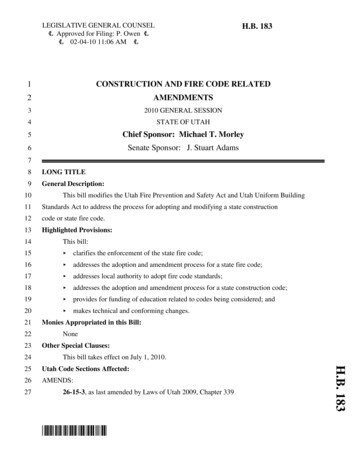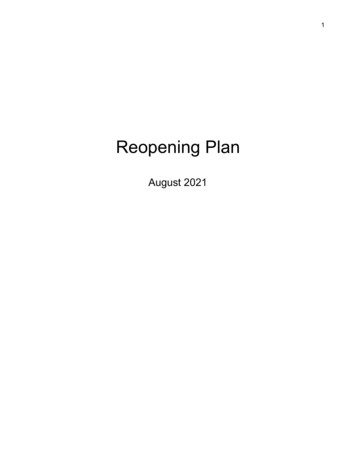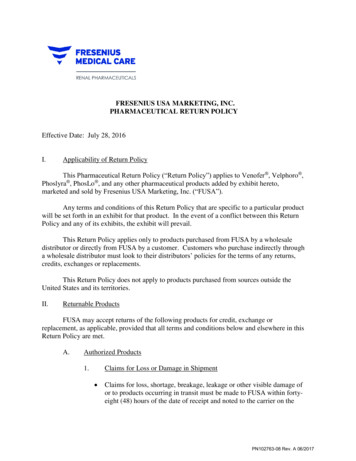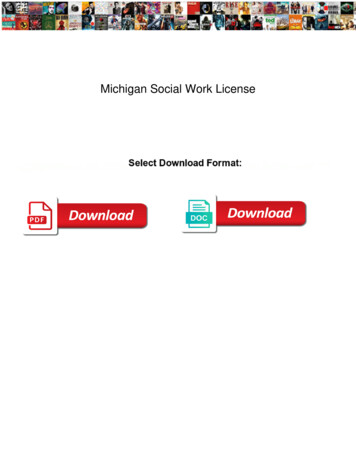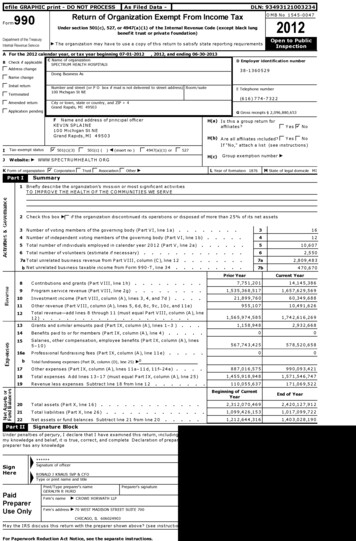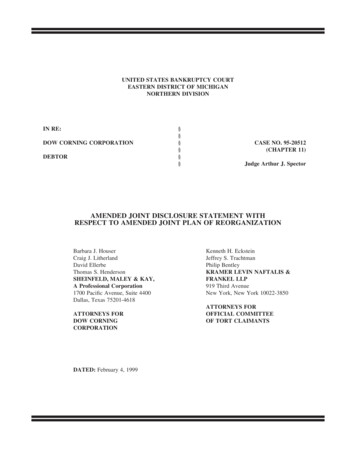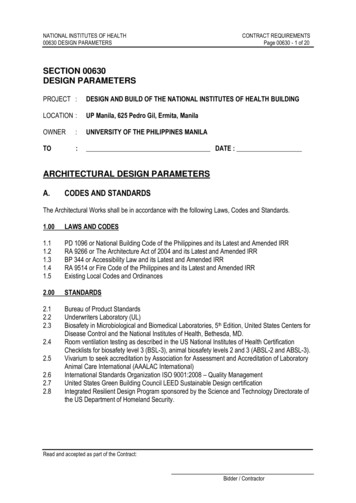
Transcription
Reset FormMichigan Department of Treasury (Rev. 05-19), Page 1 of 32019 MICHIGAN Homestead Property Tax Credit Claim MI-1040CRAmended ReturnIssued under authority of Public Act 281 of 1967, as amended.Attachment 05Type or print in blue or black ink.1. Filer’s First NameM.I.Last NameIf a Joint Return, Spouse’s First NameM.I.Last Name2. Filer’s Full Social Security No. (Example: 123-45-6789)3. Spouse’s Full Social Security No. (Example: 123-45-6789)Home Address (Number, Street, P.O. Box). If using a P.O. Box, you must complete line 45.City or TownStateZIP Code4. School District Code (5 digits - see page 60)5. Check the box(es) for which you or your spouse qualify (excluding dependents). If you qualify for both, see instructions.a.b.Age 65 or older; or an unremarried spouse of a personDeaf, blind, hemiplegic, paraplegic, quadriplegic, orwho was 65 or older at the time of death.totally and permanently disabled.6. 2019 FILING STATUS:7. 2019 RESIDENCY STATUS:*If you checked box “c,” enter dates of Michigan residency in 2019.Check one.a.SingleCheck all that apply.a.Residentb.Married filing jointlyb.Nonresidentc.Married filing separately(Include Form 5049)c.Part-Year Resident *Enter dates as MM-DD-YYYY (Example: 04-15-2019).FILERSPOUSEFROM:20192019TO:201920198. Homestead StatusCheck here if the taxable value of your homestead includes unoccupied farmland classified as agricultural by your local assessor.9. Homeowners: Enter the 2019 taxable value of your homestead (see instructions). If you did notcheck box 8 above and your taxable value is greater than 135,000, STOP; you are not eligible.Farmers: enter the taxable value of your homestead, including eligible unoccupied farmland .9.0010. Property taxes levied on your home for 2019 (see instructions) or amount from line 51, 56 and/or 5710.0012. Multiply line 11 by 23% (0.23). 12.0013. Total. Add lines 10 and 12 . 13.0011. Renters: Enter rent you paid for 2019 from line 53 and/or 55 .11.00TOTAL HOUSEHOLD RESOURCES. If filing a joint return, include income from both spouses.If married filing separately, you must include Form 5049.14. Wages, salaries, tips, sick, strikeand SUB pay, etc. .15. All interest and dividend income(including nontaxable interest).16. Net business income (including netfarm income). If negative enter “0”17. Net royalty or rent income.If negative enter “0”. .18. Retirement pension, annuity, andIRA benefits. .19. Capital gains less capital losses,(see instructions). .Alimonyand other taxable .0021. Social Security, SSI, and/orrailroad retirement benefits. .22. Child support and fosterparent payments. .23. Unemploymentcompensation. .24. Gifts received or expensespaid on your behalf. .25. Other nontaxable incomeDescribe:26. Workers’/veterans’ disabilitycompensation/pension benefits27. FIP and other MDHHS benefits(Do not include food assistance)28. SUBTOTAL. Add lines 14 through 27 . SUBTOTAL 00002019 25 01 27 921.0022.0023.0024.0025.0026.0027.0028.00Continue on page 2. This form cannot beprocessed if pages 2 and 3 are not completed and included.
2019 MI-1040CR, Page 2 of 3Filer’s Full Social Security Number29. Enter subtotal from line 28. 29.30. Other adjustments (see instructions).Describe: ourfamily31.(see instructions) . 31.000032. Add lines 30 and 31. . 32.33. TOTAL HOUSEHOLD RESOURCES. Subtract line 32 from line 29.If more than 60,000, STOP; you are not eligible for this credit. . 33.0034. Multiply line 33 by 3.2% (0.032) or by the percent in Table 2 (see instructions). If negative, enter “0”. 34.35. Subtract line 34 from line 13 and enter the amount here. If line 34 is greater than line 13, enter “0”and STOP; you are not eligible for this credit. . 35.000000PART 1: ALLOWABLE COMPUTATION Complete one of the sections below, either A, B, or C (see instructions).SECTION A: SENIOR CLAIMANTS (if you checked only box 5a)36. Enter amount from line 35 . 36.37. Percentage from Table A (see instructions) that applies to the amounton line 33 . 37.%0038. Multiply line 36 by line 37. Enter amount here and on line 42 (maximum 1,500) . 38.00SECTION B: DISABLED CLAIMANTS (if you checked only box 5b, or both boxes 5a and 5b)39. Enter amount from line 35 here and on line 42 (maximum 1,500) . 39.00SECTION C: ALL OTHER CLAIMANTS (if you did not check box 5a or 5b)40. Enter amount from line 35. .40.0041. Multiply amount on line 40 by 60% (0.60). Enter amount here and on line 42 (maximum 1,500). .41.00PART 2: PROPERTY TAX CREDIT CALCULATION All filers must complete this section.42. Enter amount from line 38, 39 or 41, or from Worksheet 3 (see instructions) for FIP/MDHHSrecipients. 42.43. Percentage from Table B (see instructions) that applies to the amounton line 33 . entageonline43.Enteramounthere44.and if you file an MI-1040, carry this amount to MI-1040, line 25. . 44.0000NOTE: Seniors who pay rent (including rent paid to adult care facilities): CompleteWorksheet 4 in the MI-1040 book and enter amount from worksheet on line 44 (maximum 1,500). 00002019 25 02 27 7Continue on page 3. This form cannot beprocessed if pages 2 and 3 are not completed and included.
2019 MI-1040CR, Page 3 of 3Filer’s Full Social Security NumberPART 3: HOMEOWNERS WHO MOVED IN 2019. Report on lines 45 and 46 the addresses of the homesteads for which youare claiming a credit. Homesteads with a taxable value greater than 135,000 are not eligible for this credit.45. Address where you lived on December 31, 2019, if different than reported on line 1 (Number, Street, City, State, ZIP Code).Taxable Value46. Address of homestead sold (moved from) during 2019 (Number, Street, City, State, ZIP Code).Taxable Value0000HOMESTEADA. Moved IntoHomeowners who moved during 2019, complete lines 47 through 51.47. Number of days occupied (total cannot be more than 365).48. Divide line 47 by 365 and enter percentage here .%49. Property taxes levied for calendar year 2019 .0050. Prorated property taxes. Multiply line 49 by the percentages on line 48 .0051. Taxes eligible for credit. Add line 50, columns A and B. Enter here and on line 10. 51.B. Moved From%000000PART 4: RENTERS52.AAddress of Homestead You Rented(Number, Street, Apt. #, City, State, ZIP Code)BCDELandowner’s Name and Address(City, State and ZIP Code)# MonthsRentedMonthlyRentTotal Rent Paid53. Total rent you paid (not more than 12 months). Add total rent for each period. Enter here and on line 11. .00000053.0000PART 5: ALTERNATE HOUSING FACILITIES (see instructions)54. If you lived in one of these types of facilities for all or part of 2019, check the appropriate box and see instructions.a.Subsidized Housing: complete line 55. Enter result on line 11.b.Service Fee Housing: complete lines 55 and 56.55. Enter the total rent you paid in 2019 while a resident of an Alternate Housing Facility. Do not includeamounts paid on your behalf by a government agency . 55.0056. If you checked box 54b, multiply line 55 by 10% (0.10) (see instructions). Enter here and on line 10. . 56.57. Special Housing: If you lived in one of these types of facilities for all or part of 2019, check the appropriate box(see instructions).a.Cooperative Housingb.Home for the Agedc.Nursing Homed.Adult Foster Care Homee.Paid Room and BoardEnter your prorated share of taxes from the type of facility checked on line 57 here and on line 10. .0057.0058. Name and Address (including City, State and ZIP Code) of Housing Facility, Landowner, or Care Facility if you completed lines 54 through 57.DIRECT DEPOSITDeposit your refund directly to your financialinstitution! See instructions and completeparts a, b and c.Deceased Taxpayer.a. Routing Transit Numberb. Account NumberIf Filer and/or Spouse died after December 31, 2018, enter dates below.ENTER DATE OF DEATH ONLY. Example: 04-15-2019 (MM-DD-YYYY)Filerc. Type of Account1.Checking2.Preparer Certification.I declare under penalty of perjury thatthis return is based on all information of which I have any knowledge.Preparer’s PTIN, FEIN or SSNSpouseTaxpayer Certification.I declare under penalty of perjury that the information in this returnand attachments is true and complete to the best of my knowledge.Filer’s SignatureDateSpouse’s SignatureDatePreparer’s Name (print or type)Preparer’s Business Name, Address and Telephone NumberBy checking this box, I authorize Treasury to discuss my return with my preparer.If you are also filing Form MI-1040, include this form behind it. If not, mail this form to: Michigan Department of Treasury, Lansing, MI 48956 00002019 25 03 27 5Savings
General Information - Homestead Property Tax Credit (MI-1040CR)The request for your Social Security number is authorizedunder USC Section 42. Social Security numbers are used byTreasury to conduct matches against benefit income providedby the Social Security Administration and other sourcesto verify the accuracy of the home heating and propertytax credit claims filed for mandatory federal reportingrequirements and to deter fraudulent filings.Who May Claim a Property Tax CreditYou may claim a property tax credit if all of the followingapply: Your homestead is located in Michigan You were a Michigan resident at least six months of 2019 You own your Michigan homestead and property taxeswere levied in 2019, or you paid rent under a rentalcontract.You can have only one homestead at a time, and you must bethe occupant as well as the owner or renter. Your homesteadcan be a rented apartment or a mobile home on a lot in amobile home park. A vacation home or income property isnot considered your homestead.Your homestead is in your state of domicile. Domicile is theplace where you have your permanent home. It is the placeto which you plan to return whenever you go away. Collegestudents and others whose permanent homes are not inMichigan are not Michigan residents. Domicile continuesuntil you establish a new permanent home.Property tax credit claims may not be submitted onbehalf of minor children. Filers claimed as a dependenton someone else’s return see instructions for line 24 onpage 32 to correctly report support received.You may not claim a property tax credit if your totalhousehold resources are over 60,000. In addition, youmay not claim a property tax credit if your taxable valueexceeds 135,000 (excluding vacant farmland classified asagricultural). The computed credit is reduced by 10 percentfor every 1,000 (or part of 1,000) that total householdresources exceed 51,000. If filing a part-year return, youmust annualize total household resources to determine if theincome limitation applies. See “Annualizing Total HouseholdResources” on page 29.Which Form to FileMost filers should use the MI-1040CR in this booklet. If youare blind and own your homestead, are in the active military,are an eligible veteran, or an eligible veteran’s survivingspouse, complete forms MI-1040CR and MI-1040CR-2(available on Treasury’s Web site.) Use the form that givesyou a larger credit.If you are blind and rent your homestead, you cannot usethe MI-1040CR-2. Claim your credit on the MI-1040CR andcheck box 5b if you are age 65 or younger. Check boxes 5aand 5b if you are blind and age 65 or older.When to FileIf you are not required to file an MI‑1040, you mayfile your credit claim as soon as you know your 2019total household resources and property taxes levied in262019. If you file a Michigan income tax return, yourcredit claim should be included with your MI-1040return and filed by April 15, 2020 to be consideredtimely. To avoid penalty and interest, if you owe tax,postmark your return no later than April 15, 2020. Thefiling deadline to receive a 2019 property tax credit isApril 15, 2024.Amending Your Credit ClaimFile a new claim form and check the Amended Return box atthe top of page 1 of the form. If applicable, include a copyof your property tax statement(s) and/or lease agreement.You must file within four years of the date set for filing youroriginal income tax return.Delaying Payment of Your Property TaxesSenior citizens, disabled people, veterans, surviving spousesof veterans, and farmers may be able to delay payingproperty taxes. Contact your local or county treasurer formore information.Total Household ResourcesTotal household resources are the total income (taxable andnontaxable) of both spouses or of a single person maintaininga household. They are AGI, excluding net business and farmlosses, net rent and royalty losses, and any carryover of a netoperating loss, plus all income exempt or excluded from AGI.Total household resources include the following items notlisted on the form: Capital gains on the sale of your residence regardless if thegains are exempt from federal income tax Compensation for damages to character or for personalinjury or sickness An inheritance (except an inheritance from your spouse) Proceeds of a life insurance policy paid on the death of theinsured (except benefits from a policy on your spouse) Death benefits paid by or on behalf of an employer Minister’s housing allowance Forgiveness of debt, even if excluded from AGI (e.g.,mortgage foreclosure) Reimbursement from dependent care and/or medical carespending accounts Scholarships, stipends, grants, and payments, exceptgovernment payments, made directly to third parties suchas an educational institution or subsidized housing project.Total household resources do NOT include: Net operating loss deductions taken on your federal return Payments received by participants in the fostergrandparent or senior companion program Energy assistance grants Government payments made directly to a third party (e.g.,payments to a doctor, GI Bill benefits, payments from aPELL grant).NOTE: If payment is made from money withheld fromyour benefit, the payment is part of total householdresources. (For example, the MDHHS may pay your rentdirectly to the landlord.)
M oney received from a government unit to repair orimprove your homestead Surplus food or food assistance program benefits State and city income tax refunds and homestead propertytax credits Chore service payments (these payments are income to theprovider of the service) The first 300 from gambling, bingo, lottery, awards, orprizes The first 300 in gifts of cash or merchandise received, orexpenses paid on your behalf (rent, taxes, utilities, food,medical care, etc.) by parents, relatives, or friends Amounts deducted from Social Security or RailroadRetirement benefits for Medicare premiums Life, health, and accident insurance premiums paid byyour employer Loan proceeds Inheritance from a spouse Life insurance benefits from a spouse Payments from a long-term care policy made to a nursinghome or other care facility Most payments from The Step Forward Michigan program. Compensation for wrongful imprisonmentVisit www.michigan.gov/taxtotalhouseholdresources formore information on total household resources.Special Provisions for FarmersIf you received a farmland preservation tax credit in 2019,you must include it in total household resources. You maysubtract the business portion of your homestead property taxcredit if you included it in taxable farm income. A homesteadproperty tax credit is allowed only if the gross receipts fromfarming exceed total household resources.Property Taxes Eligible for CreditAd valorem property taxes that were levied on yourhomestead in 2019, including administrative collectionfees up to 1 percent of the taxes, can be claimed no matterwhen you pay them. You may add to your 2019 taxes theamount of property taxes billed in 2019 from a correctedor supplemental tax bill. You must deduct from your 2019property taxes any refund of property taxes received in 2019that was a result of a corrected tax bill from a previous year.Do not include: Delinquent property taxes (e.g., 2018 property taxes paidin 2019) Penalty and interest on late payments of property tax Delinquent water or sewer bills Property taxes on cottages or second homes Association dues on your property Most special assessments for drains, sewers, and roads donot meet specific tests and may not be included. You mayinclude special assessments only if they are levied using auniform millage rate, are based on taxable value, and areeither levied in the entire taxing jurisdiction or they areused to provide police, fire, or advanced life supportservices and are levied township-wide, except for all or aportion of a village.NOTE: School operating taxes are generally only leviedon the non-homestead portion of the property and may notbe included in taxes levied when computing the property taxcredit on any portion of the home not used as your homestead.Home used for business. If you use part of your home forbusiness, you may claim the property taxes on the living areaof your homestead, but not the property taxes on the portionused for business. Include a copy of U.S. Form 8829 with yourMichigan return.Owner-occupied duplexes. When both units are equal,you are limited to 50 percent of the tax on both units, aftersubtracting the school operating taxes from the total taxesbilled.Owner-occupied income property. Apartment building andduplex owners who live in one of the units or single familyhomeowners who rent a room(s) to a tenant(s) must completetwo calculations to figure the tax they can claim and base theircredit on the lower amount. First, subtract 23 percent of therent collected from the tax claimed for credit. Second, reducethe tax claimed for credit by the amount of tax claimed asrental expense on your U.S. Form 1040, Schedule 1. Include acopy of the U.S. Schedule E with your Michigan return.Example: Your home has an upstairs apartment that is rentedto a tenant for 395 per month. Total property taxes on yourhome are 2,150. Of this amount, 858 is claimed as rentalexpense. The calculations are as follows:Step 1: 395 x 12 4,740 annual rent 4,740 x 0.23 1,090 taxes attributable to the apartment 2,150 total taxes - 1,090 1,060 taxes attributable to owner’shomesteadStep 2: 2,150 total taxes - 858 taxes claimed as a businessdeduction 1,292 taxes attributable to homesteadStep 3:The owner’s taxes that can be claimed for credit are 1,060,the smaller of the two computations.Farmers. Include farmland taxes in your property tax creditclaim if any of the following conditions apply: If your gross receipts from farming are greater than yourtotal household resources, you may claim all of your taxeson unoccupied farmland classified as agricultural. Do notinclude taxes on farmland that is not adjacent orcontiguous to your home and that you rent or lease toanother person. If gross receipts from farming are less than your householdincome and you have lived in your home more than tenyears, you may claim the taxes on your home and thefarmland adjacent and contiguous to your home. If gross receipts from farming are less than yourhousehold income and you have lived in your home lessthan ten years, you may claim the taxes on your home andfive acres of farmland adjacent and contiguous to yourhome.You may not claim rent paid for vacant farmland whencomputing your property tax credit claim. Farmland ownedby a business entity may not be claimed for a homesteadproperty tax credit by one of the individual members.Include any farmland preservation tax credit in your totalhousehold resources. Enter the amount of credit you receivedin 2019 on line 20 or include it in net farm income on line 16.27
Homestead property tax credits are not included in totalhousehold resources. If you included this amount in yourtaxable farm income, subtract it from total householdresources.Rent Eligible for CreditYou must be under a lease or rental contract to claim rent forcredit. In most cases, 23 percent of rent paid is consideredproperty tax that can be claimed for credit. The followingare exceptions: If you rent or lease housing subject to a service charge orfees paid instead of property taxes, you may claim a creditbased upon 10 percent of the gross rent you paid. Enter thisamount on line 55 and 10 percent of rent paid on line 56,and follow instructions. If your housing is exempt from property tax and noservice fee is paid, you are not eligible for a credit. Thisincludes university- or college-owned housing. If your housing costs are subsidized, base your claim onthe amount you pay. Do not include the federal subsidyamount. If you are a mobile home park resident, claim the 3 permonth specific tax on line 10, and the balance of rent paidon line 11. If you are a cooperative housing corporation residentmember, claim your share of the property taxes on thebuilding. If you live in a cooperative where residents payrent on the land under the building, you may also claim23 percent of that land rent. NOTE: Do not take 23percent of your total monthly payment. If you are a resident of a special housing facility (notnoted above), base your claim on rent only. Do not includeother services. If you pay rent with other services and youare unable to determine the portion that constitutes rentonly, you may determine your portion of the propertytaxes that can be claimed for credit based on squarefootage, or, divide the taxes by the number of residents forwhom the home is licensed to care. This information maybe obtained from your housing facility. Visitwww.michigan.gov/iit for more information aboutclaimants living in special housing facilities.Example: You pay 750 per month for room and board. Youoccupy 600 square feet of a 62,000 square foot apartmentbuilding. The landlord pays 54,000 in taxes per year.Step 1: 600/62,000 0.0097Step 2: 54,000 x 0.0097 524 taxes you can claim for creditHome used for business. If you use part of your apartmentor rented home for business, you may claim the rent on theliving area of your homestead, but not the rent on the portionused for business.If You Moved in 2019Residents who temporarily lived outside Michigan mayqualify for a credit if Michigan remained their state ofdomicile. Personal belongings and furnishings must haveremained in the Michigan homestead and the homesteadmust not have been rented or sublet during the temporaryabsence. (See the definitions of resident on page 6 anddomicile on page 26.)If you bought or sold your home or moved during2019, you must prorate your taxes. Complete MI-1040CR,28Part 3, to determine the taxes that can be claimed forcredit. Use only the taxes levied in 2019 on each Michiganhomestead, then prorate taxes based on days of occupancy.Do not include taxes on out-of-state property. Do not includeproperty taxes for property with a taxable value greaterthan 135,000. Excluded from this restriction is unoccupiedfarmland classified as agricultural by your assessor.Part-Year ResidentsIf you lived in Michigan at least six months during the year,you may be entitled to a partial credit. If you are a part-yearresident, you must include all income received as a Michiganresident in total household resources (line 33). CompleteMI-1040CR, Part 3, to determine the taxes eligible to beclaimed for credit on your Michigan homestead.Deceased Claimant’s CreditThe estate of a taxpayer who died in 2019 (or 2020 beforefiling a claim) may be entitled to a credit for 2019. Thesurviving spouse, other authorized claimant, or personalrepresentative can claim this credit. Use the decedent’s nameand Social Security number and the personal representative’saddress. If the taxpayer died after December 31, 2018, enterthe date of death in the “Deceased Taxpayer” box on page 3.The surviving spouse is considered married for the year inwhich the deceased spouse died and may file a joint creditfor that year. Enter both names and Social Security numberson the form, and write “DECD” after the decedent’s name.Sign the return and write “filing as surviving spouse” inthe deceased’s signature line. Enter the date of death in the“Deceased Taxpayer” box on the bottom of page 3. Includethe decedent’s income in total household resources.If filing as a personal representative or claimant for therefund of a single deceased taxpayer, you must includea U.S. Form 1310 or Michigan Claim for Refund Due aDeceased Taxpayer (MI-1310). Enter the decedent’s namein the Filer’s Name line and the representative’s or claimant’sname, title and address in the Home Address line. See the“Deceased Taxpayer Chart of Examples” on page 7. Aclaimant must prorate to the date of death as noted in thefollowing paragraph.The personal representative or claimant claiming a creditfor a single deceased person or on a jointly filed creditif both filers became deceased during the 2019 tax year,must prorate taxes to the date of death. Complete lines 47through 51 to prorate the property taxes. Annualize totalhousehold resources (see instructions below). Include a copyof the tax bills or lease agreements. If filing as a personalrepresentative or claimant of deceased taxpayers for ajointly filed return, you must include a U.S. Form 1310or Michigan Claim for Refund Due a Deceased Taxpayer(MI-1310). Enter the name(s) of the deceased person(s) in theFiler’s and/or Spouse’s Name lines and the representative’s orclaimant’s name, title, and address in the Home Address line.See “Deceased Taxpayer Chart of Examples” on page 7.Annualizing Total Household ResourcesIf you are filing a part-year credit (for a deceased taxpayer ora part-year resident), you must annualize the total householdresources to determine if the credit reduction applies.(Exception: the surviving spouse filing a joint claim does nothave to annualize the deceased spouse’s income.)
I f you have checked a box on line 5 and your annualizedtotal household resources are less than 6,000 use yourannualized total household resources to determine yourpercentage of taxes not refundable from MI-1040CRTable 2 on page 33. A senior, age 65 or older, filing a part-year credit mustcalculate annualized total household resources beforeusing MI-1040CR Table A on page 33. If the annualized income is more than 51,000 for anyclaimant, use annualized total household resources todetermine the percentage allowable in MI-1040CRTable B on page 33.To annualize total household resources, which projectswhat it would have been for a full year:Step 1: Divide 365 by the number of days the taxpayer was aMichigan resident in 2019.Step 2: Multiply the answer from step 1 by the taxpayer’stotal household resources (MI-1040CR, line 33). The result isthe annualized total household resources.Married During 2019If you married during 2019, combine each spouse’s share oftaxes or rent for the period of time you or your spouse livedin separate homesteads prior to getting married. Then addthis to the prorated taxes or rent for your marital home afteryour marriage. You are only allowed to claim rent and taxeson homesteads located in Michigan.Filing a Joint Return and Maintaining SeparateHomesteadsYour claim must be based on the tax or rent paid on onlyone home during a 12 month period. The total householdresources must be the combined income of both you and yourspouse for the entire year.Married Filing Separately and Divorced orSeparated Claimants Schedule (Form 5049)This form can be found at www.michigan.gov/taxes.Submit Form 5049 with Form MI-1040CR, MI-1040CR-2 orMI-1040CR-7 if any of the following situations apply to you: You filed as married filing separately, and you and yourspouse maintained separate homesteads all year. Completeonly Part 3 of Form 5049. You filed as married filing separately, and you shared ahomestead with your spouse all year. You filed as married filing separately, and you and yourspouse maintained separate homesteads at the end ofthe year.Filing Separate State Returns and MaintainingSeparate HomesteadsSpouses who file separate Michigan income tax returns anddid not share a household during the tax yea
Your homestead is located in Michigan You were a Michigan resident at least six months of 2019 Youwnour o y Michigan homestead and property taxes wereevied l in 2019,rouaid o y p rent under a rental contract. Youanave c h only one homesteadtime,nda a t a you must be theccupant o as well as the owner or renter. Your homestead

